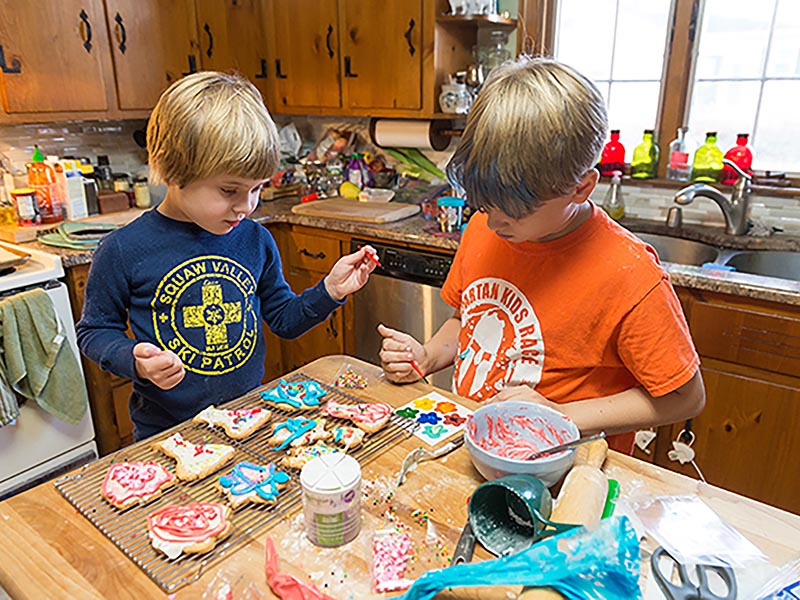
Jodin and Ashley, an interfaith couple, learn to bake challah with InterfaithFamily. Photo courtesy of InterfaithFamily
BOSTON (RNS) — When Rabbi Rachel Saphire was a child, her Jewish mother gave a special spin to the Hanukkah message that acknowledged her family’s two faiths.
Although Saphire’s father was Christian, she was taught that, like the Maccabees who reclaimed the Jerusalem Temple from Syrian-Greeks in the second century B.C., their family would be among “the ones to preserve the (Jewish) tradition, even fighting for it,” Saphire recalls.
Today, however, that spin no longer works for many interfaith families, said Saphire, who is associate rabbi at Temple Beth Elohim in Wellesley, Mass. A Christian father doesn’t need to be thought of as supportive of Jewish life in spite of his different faith.
Speaking recently at the Union for Reform Judaism’s Biennial gathering in Boston on a panel calling interfaith marriage “The New Normal,” Saphire said Jewish communities today are more supportive and inclusive than in previous generations.
How interfaith families are welcomed into the life of a congregation is a critical factor in keeping them connected to Judaism. And the language of this inclusion effort matters to these families, perhaps more than ever, the panelists agreed.
To this end, Jewish leaders and clergy are looking in new ways at how people speak about — and to — interfaith couples and families, hoping to ensure they do not feel like outsiders in congregational life in prayers, traditions and leadership roles. The Reform movement, the largest stream of Judaism in the U.S., with the largest proportion of Jews who marry outside their faith, is taking the lead on the issue.
[ad number=“1”]
Start by letting go of the “non-“ prefix, said Jodi Bromberg, CEO of InterfaithFamily, an organization based in the Boston area that supports interfaith families.
“If you haven’t already stopped using the term ‘non-Jew,’ do it now,” Bromberg told the panel’s audience of congregational leaders and clergy.
No one has landed on an adequate replacement term for “interfaith,” but not for lack of trying. Many don’t consider the term inclusive enough.
April Baskin, the URJ’s vice president of “audacious hospitality,” uses the term “Jewish-and” to refer to Jews who have different racial, cultural or religious aspects to their identities.
Rabbi Amichai Lau-Lavie, a Conservative rabbi, left the movement’s Rabbinical Assembly last year over his decision to officiate at interfaith weddings — a stance the movement does not support. He like the term “Joy:” a combination of “Jew” and “goy,” the Yiddish word for “nation,” which generally refers to non-Jews.
Lau-Lavie uses “Joy” in weddings he performs at Lab/Shul, his experimental congregation in New York City. In addition to being a clever portmanteau, he argues the term is grounded in Jewish tradition, noting that medieval rabbis had a term for a non-Jew who lives in Jewish communities and accepts the authority of the Torah. Those rabbis called such a person a “ger toshav,” or “resident alien.”
Lau-Lavie maintains that engaging “Joy” couples is crucial as the demographics of American Judaism continue to evolve.
In 2013, the Pew Research Center found that seven in 10 non-Orthodox Jews who had married since 2000 wed non-Jewish spouses.
“This is not a drop in the ocean,” said Bromberg, “This is the ocean.”
Statistics aside, many people consider their identities to be “fluid,” scholars say.
“The notion that you’re this or you’re that is something that might not last another generation,” said Rabbi Shaul Magid, a professor of Jewish studies at Indiana University in Bloomington. “From within the Jewish orbit, we can lament that, or we can actually try to get on top of it and figure out what that might mean for the Jews in the next little while.”
For some Jews, this translates into shifting from a tone of “welcoming” to one of “inclusion.”
Temple Shir Tikva, a Reform congregation in Wayland, Mass., has worked in recent years through its Interfaith Families Committee to fully engage interfaith couples.
“Welcoming makes you feel like you’re a guest,” said Heather Meterparel, who chairs the committee and was raised as a Catholic. “Inclusion is, ‘you belong here.’”
That means reaching out to extended family members — parents, former spouses, cousins, or grown children’s spouses — who identify with other faiths.

Alex and Eli Wettengel, ages 10 and 5, decorate holiday cookies at their home in Massachusetts. The brothers are being raised by parents who come from different religious backgrounds. Photo courtesy of InterfaithFamily
To aid them, the congregation provides a companion to the prayer book offering translation and explanation of Hebrew prayers and rituals.
Unlike the Reform movement, which discourages but does not prohibit rabbis from officiating at interfaith weddings, the Conservative movement still officially forbids the practice, even as some of its rabbis question it.
[ad number=“2”]
In a recent letter reaffirming its stance, the Conservative movement encouraged rabbis to cultivate a “rabbinic relationship that is broader and deeper” than a wedding — with a goal of helping non-Jewish spouses consider converting to the faith.
For some rabbis, that approach is inadequate because it asks non-Jewish spouses to check their faith histories at the synagogue door.
Some are experimenting with descriptive language that doesn’t reduce the complexity of “interfaith” couples and families to that catch-all term.
“It just seemed like the term wasn’t intellectually honest; it wasn’t an accurate term,” said Rabbi Darby Leigh, who is ordained by the small but influential Reconstructionist Jewish movement. At his congregation, Kerem Shalom in Concord, Mass., he prefers to speak of “families where individuals come from different faith backgrounds.”
[ad number=“3”]
Susan Katz Miller, author of the 2014 book “Being Both: Embracing Two Religions in One Interfaith Family,” continues to use “interfaith” because it works for families that have chosen to practice only Judaism, as well as those that maintain both parents’ traditions.
She said Jewish institutions exclude two-faith families at their peril if they want to foster participation and connection in future generations.
Said Miller, “The Jewish community should and, in fact, must look beyond those families who are doing that all-but-conversion Jewish pathway.”





